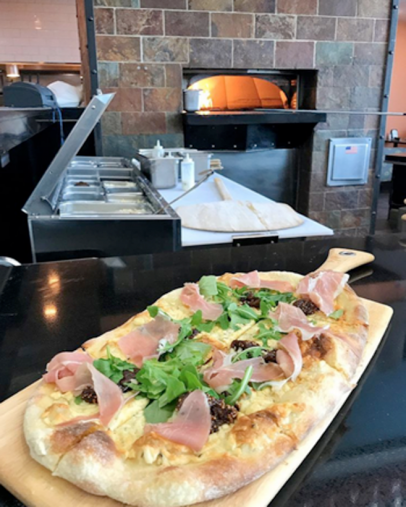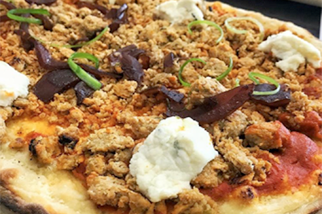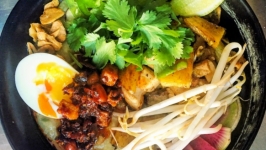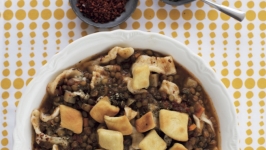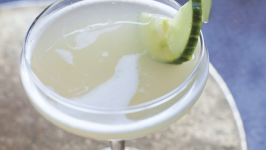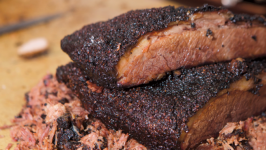Your Next Great Meal Might Be at the Airport
Settled in at a long, wooden communal table, you take a bite into house-made cavatelli pasta featuring fava beans and hen-of-the-wood mushrooms sourced from a few miles away. You sip on your made-in-Montauk Hop Blonde Ale. Close your eyes and imagine that meal. Chances are you’re seeing a simple, yet rustic setting. There’s the low hum of conversations from other tables in the background, maybe even some light music playing. I bet you’re not envisioning a restaurant inside an airport.
“You shouldn’t have to go to the airport and put aside your standards,” says Michael Levine, the CEO of Tastes on the Fly, a boutique airport dining operator that provides services locally to JFK, as well as airports in Boston, San Francisco and Denver.
The table setting may not be elegant, and the background noise is probably boarding announcements, but the food and libations are more likely than ever before to feature ingredients from nearby farms, made by local restaurants and chefs. At LaGuardia, JFK and other airports around the country, airlines and their food partners are creating chef-driven restaurants, sophisticated wine menus, craft cocktails and farm-fresh options, some of which may have come from just outside the terminal.
JetBlue, which opened a 24,000-square-foot farm in partnership with GrowNYC in 2015, right outside JFK’s Terminal 5, is trying to use the time people spend in airports to educate them about farming. The farm, visible from the departures level, grows produce like the potatoes that become those blue chips offered on JetBlue flights, as well as leafy greens and herbs used by other Terminal 5 businesses.
In what is often an experience riddled with never-ending security queues, prodigious delays and shrinking seats, airport food has become a rare bright spot for weary travelers. It marks a triumphant return to the golden age of airport travel.
“Years and years ago, airports were an attraction and people would go to the airport to eat and watch the planes,” says Stephen Zagor, dean of restaurant and culinary management at the Institute of Culinary Education.
But as air travel became more popular and airports didn’t have to compete as much with trains and cars, dining options evolved. According to Zagor, starting in the 1970s, corporate food contractors began running both on-board and on-the-ground dining operations. As most airlines began offering complimentary in-flight meals, airports became more interested in feeding people than creating a dining experience. The result was fast, impulse food. Fast-casual, of course, still exists today, and is an airport staple, but as the market has changed, so has the quality and variety of foods offered from terminal to terminal.
Levine says of the shift, “Airports started to say, ‘We don’t have to do this.’ Now, most airports are a mix of local, regional and national names.”
If you’ve taken a flight out of either LGA or JFK in the past few years, you’ve seen what Levin means. Yes, there’s Starbucks and Wendy’s and McDonald’s, but at JFK, where JetBlue and Terminal 5 have in many ways led the transformation of dining options, there are also spots like Marcus Samuelsson’s sit-down restaurant, Uptown Brasserie. The Terminal 4 Southern eatery dishes up classic fare like chicken and waffles, catfish sandwiches and buttermilk pancakes, and the posh Tastes on the Fly–operated Bobby Van Steakhouse in Terminal 8 serves everything from morning omelets to cobb salad and steaks for lunch or dinner.
This spring at LGA, Delta and its dining partner OTG worked with Chef Andrew Carmellini, of New York City restaurants including Lafayette and The Dutch, to develop a menu of hyper- seasonal and locally sourced dishes (think: a salad of beet, shrimp and hearts of palm, topped with micro watercress) for Terminal D’s Prime Tavern. Meanwhile in Terminal B, celebrity chef Todd English and Centerplate, which operates dining venues at more than 300 locations in the U.S. (including kiosks at LGA), were busy launching a new menu at Figs Restaurant, serving dishes such as cauliflower risotto, portobello paninis and flatbreads.
“Airport dining has followed a similar trajectory as many other types of venues where we operate—convention centers, stadiums, arenas, zoos, even amusement parks. They are becoming more of a destination for quality food, and it is our responsibility to enhance what we offer for our guests there,” said Centerplate’s Chief Marketing Officer Bob Pascal.
The appeal of operating inside an airport is obvious: a plethora of passengers forced to cool their heels in a confined space, a captive audience. But that doesn’t mean it’s easy. Rents are high, competition is stiff and there’s no control over the market. The challenge for chefs and their dining partners is finding a way to translate their restaurant concept in an authentic way.
“We have the exact same recipe standards and training as we would at the restaurant. At Bobby Van’s, everyone is trained in the kitchens in Manhattan,” Levine says. But while airports are getting on board with sit-down, farm-to-table dining, it’s not something that will work for everyone. According to Zagor, the majority of airport travelers spend less than $10 at the airport, and while business passengers are more inclined to spend on food, they make up less than half of all airport travelers. Non-business travelers without expense accounts likely aren’t as willing to shell out as much on airport food, Zagor says, and they may also not be interested in it. The latest survey from the Airports Council International-North America reports that passengers spent an average of $6.32 on food and beverage per enplanement in 2015.
Airports are focusing on those travelers. At LGA, acclaimed East Village pizzeria Artichoke has operated for the past six years in partnerships with OTG. They’re now redoing their menu. “We’ve developed a way to sell pizza out of to-go pans. The individual pies look better, they’re a lot easier for people on the go and travel better than slices,” said Francis Garcia, co-owner of Artichoke.
Similarly, Centerplate designs all of its menus to be to-go friendly, and iPads throughout LGA’s Terminal D make it easier for people to order a cup of coffee without having to worry about a kid walking away from them while waiting in the checkout line.
Who knows? With the push for more exquisite airport dining, perhaps LaGuardia and JFK will soon become destinations unto themselves. Luckily, both airports are conveniently located right here in our borough.
Tastes on the Fly
JetBlue | @jetblue
Institute of Culinary Education | @iceculinary
Marcus Samuelsson | @marcuscooks
Uptown Brasserie | @uptownbrasserie
Bobby Van Steakhouse | @bobbyvansteak
Chef Andrew Carmellini
Lafayette | @lafayette380
The Dutch | @thedutchnyc
Prime Tavern
Todd English | @cheftoddenglish
Figs Restaurant
Artichoke | @artichokepizza


